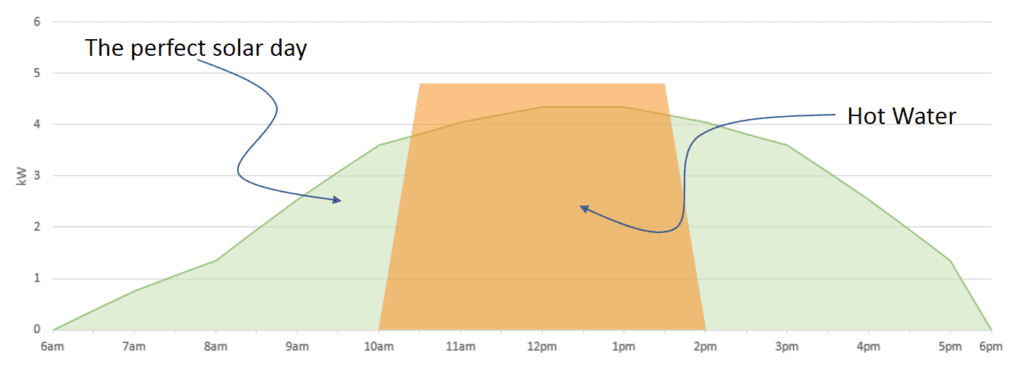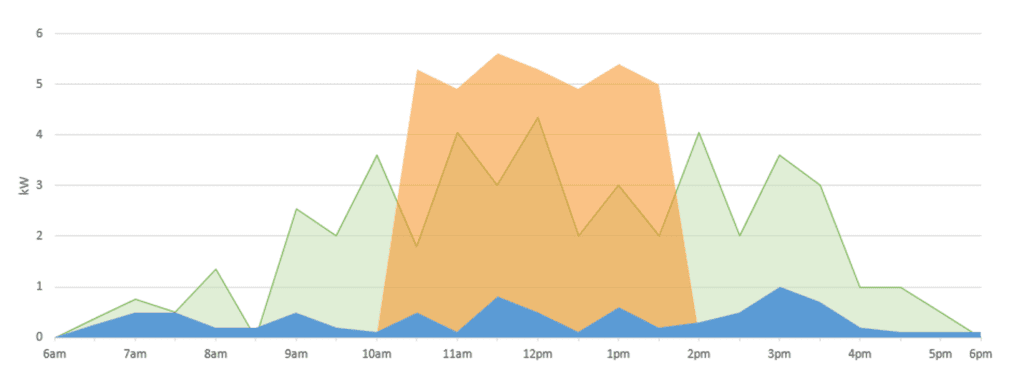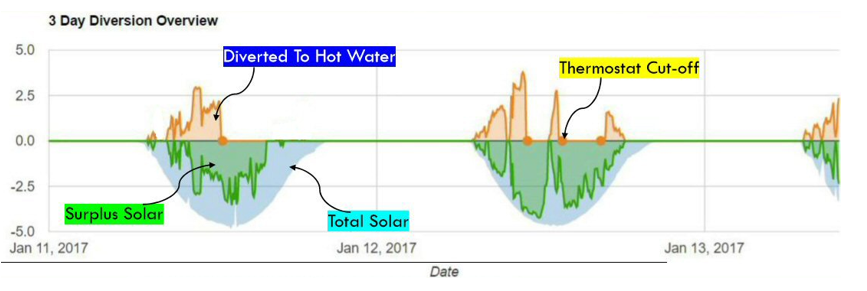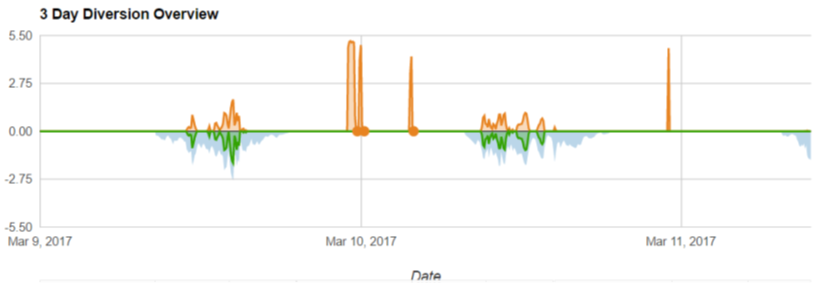The article below, written by Scott Young of CATCH Power, provides a look into the world of hot water diverters, which use excess solar energy to drive the element in electric storage-based water heaters. Hot water diverters are a great way to increase solar self-consumption and are significantly more affordable (albeit less versatile) than battery storage at this point in time. There are a range of hot water diverter options available in Australia; we have an (incomplete) list at the bottom of this article.
Please keep in mind that the example from this article may not be relevant to your situation, as water heating and solar setups differ from person to person. Also note that different diverter products have different functions and capabilities and other units may not operate as described below (CATCH Power, for example, uses an internet connection and predictive algorithm to optimise performance in some of its products.)
Compare solar quotes from installers in your area
And don’t forget to ask about hot water diverters!
We hear people talking about installing timers for hot water all the time. Do timers actually help solar homes to reduce their hot water usage charges? Although it may seem like a smart idea, the answer is unfortunately ‘no’ in most cases. We explain why this is the case in this article.
How heating water on a timer can actually cost you more
In most situations installing a timer for your hot water will cost you money. There are two simple reasons for this:
- When the timer turns on, you will be importing energy most of the time.
- For every 1 unit of electricity imported, your solar needs to create at least 2.
The elusive ‘perfect’ solar day
Lets start by looking at the perfect solar day. The graph below shows how a 5kW solar system is likely to perform on a perfect solar day. We have added in a typical hot water heating load being run on a timer (the orange stuff).
As you can see from the chart, if you have a 5kW solar system, and you have a perfect solar day the bulk of your hot water is in fact heated by the solar. But even with the perfect solar day you are buying some of the electricity from the grid.
Any of the hot water power that appears above the solar curve is energy purchase from the grid.
It is important to understand, the perfect solar day is like a Unicorn; they are exciting, some people have claimed to see them, but for most people they are always just out of reach. How do we know this? Because CATCH Power has hundreds of internet-connected, ‘smart’ hot water diverters installed, and we see the ‘real’ solar day playing out all over the country on a daily basis.
The typical solar day
So if we are claiming the perfect solar day is hard to come by, what does a typical solar day look like?
Again, we can look to the data from the CATCH hot water diverter units installed around the country, which shows what is actually happening in the home. The below graph shows you what a typical solar day looks like (in Summer).
The solar output looks a lot different when you start dealing with real weather and real solar yields. We have also added in the average daytime loads into the graph and sat the hot water load on top of it (because that’s how it often works with a timer).
You can see from this graph there is significantly more energy being purchased from the grid now. Also keep in mind this is an average day in the middle of summer. Things are even more diabolical in the winter months.
In order for you to save money putting your hot water on a timer, it is critical to make sure you are exporting two times more energy than you are buying from the grid. Using this average day as the test we can visually see this is not the case, in fact if the above graph was your house, you would have lost money on that day.
Here’s what we’ve observed from the data: if you have a 5kw solar array, there are only a handful of days in a year where putting a timer on your hot water equates to net savings. If your solar system capacity is less than 5kW, there are NO days in the year.
Taking a closer look
Where does this “export 2 for every 1 unit purchased” idea come from? It has to do with electricity tariff arrangements.
Lets make some assumptions:
- The cost of full tariff electricity is 26 cents
- The cost of Off Peak electricity is 10 cents
- The solar export rate is 8 cents
Now before you email us with disagreement about these numbers – I know there are some places in Australia where some of the electricity rates are significantly cheaper than our assumptions, and equally there are people choking on their Weetbix because they are paying a lot more, so I think these are fair assumptions.
Lets start by assuming we need to put 1kWh of energy into our hot water tank to get it hot.
Before there were solar panels and timers, and smart hot water diverters, off peak electricity was the only option to get that 1kWh of energy, which would have cost us 1 x 10 cents = 10 cents.
Now, along come our good friends the solar installation company, who say to you, “We can put your hot water on a timer. It will help improve the savings you get from your solar system.” So you decide to do it.
You now have a shiny new solar system, and your hot water is now running on a timer.
As it turns out, your first day of water heating turns out to be a rainy one (because – as everybody who owns solar knows – it usually rains for a week after you first get it installed). There is not enough solar being produced to cover all of your hot water load. That 1kWh of energy we used to get from off peak is now coming from the full tariff mains, so 1kWh costs 1 x 26 cents = 26 cents.
Now, before solar came along it used to cost 11 cents, but today it cost 26 cents, so we are in the hole by 26 – 10 = 16 cents.
But it is not all doom and gloom, there is time later in the day where we are exporting solar to the grid, so we can recoup our losses there. But in order to earn back that 16 cents we need to sell 16/8 cents = 2 kWh into the grid.
That is where the 2 for 1 comes in – and that is just to get you back to neutral a position! You need to keep selling back to the grid to actually make any real savings.
How a diverter fixes the problem
If timers don’t work, how does a smart hot water diverter fix the problem?
A solar diverter, such as CATCH, will not just identify what part of your solar is available to be used for hot water heating; it will also track it perfectly, all through the day, regardless of the solar output and the loads that come on in the house.
The above graph is taken from a real life working Blue CATCH installation. As you can see from the graph, January 11th was a fantastic solar day. But it was a hot day and there was a load (or series of loads) running in the house all day. At this time of the year, on a sunny day, it was most likely an air conditioner. The green area is the amount of energy that is surplus to the home through the day. If this hot water system had been running on a timer it would have been a very expensive hot water heating day.
As you can see from the graph, the energy delivered into the hot water tank (shown in orange) is matched perfectly to the amount of surplus solar available, as the surplus changes so does the rate of energy delivery to the hot water tank – until the thermostat cut-off was reached (orange dot). Clearly seen on the graph, the total amount of energy available (over a longer period of time) was enough to do the job of heating the water until cutoff. At no point was mains power required to do any of the heating job.
On a cloudy day
What about when the weather is cloudy or rainy? There will be little or no surplus solar to divert to the hot water tank.
If your diverter is smart, and connected to the internet (like Blue CATCH), then it ‘knows’ that tomorrow will be a poor solar day and make a decision to utilise the off-peak power to heat the water. This way, if a supplementary power source is required, it is the next cheapest power source, and not mains tariff power.
Here is an example:
In this example, there wasn’t enough solar to do the complete heating job on March 10th. CATCH anticipated this the night before and drew upon the off-peak to get the job done. A very small amount of off-peak (the orange spike late on the 10th) was calculated to be required to get the job started for the 11th.
In conclusion, installating a timer to heat your hot water with solar will very likely cost you money over the year. Only a smart hot water diverter is able provide the real savings you are expecting from your solar installation.
Get a free, instant Solar Quote Comparison
Interested in a hot water diverter? Speak with installers about their options.
- Water heating on a timer vs solar diverter: A case study - 22 June, 2017




Surely you also need to take account of cost of the ‘intelligent’ diverter as well?
I was quite impressed by the idea of CatchPower until I found it would cost me north of a $1,000 and once that is taken into account the economics of it changed
The potential save is entirely dependent on the solar system size. With a 1 Kw system it would be hard to see how it could benefit you, with a 10kW system (assuming the hot water needs 10 KwH a day of power) it is also hard to imagine the extra cost of the CatchPower could be justified by the amounts of mains power saved.
So where it does make sense at this price point for some solar systems of particular sizes with particular self consumption patterns, it is hardly a ‘slam dunk’.
At $100 per unit it would be a different story.
That said, you would expect that once someone HAD their data from the smart meter over a period, it would be pretty simple to for CatchPower to run a simulation given this data and the site address (plus an estimate of how much power the hot water system needs) and tell a potential client exactly how much they would save and the system payback time.
They could even put this on their website where folks could check for themselves.
Add some more transparency on pricing (and drive it down, incremental cost to supply must be low here) and now you might have something – rather than the arm waving above.
Hi Richard, thank you for your comments regarding CATCH.
The product doesn’t suit all households. It is true that a home with a 1kW array the usefulness would be negligible. And indeed, it would depend on the load patterns of the home. The sweet spot is a home with 4kW of solar and four or people in the home. In this case the house may use ann average of 8kWhrs/day in hot water energy. Let’s take an off-peak rate of $0.15/kWh. This equates to $1.20/day in hot water. The surplus solar, via Green CATCH, would be able to supply 85% of this energy, which is $1.02/day. This equates to $372.30/year, which is a payback of less than three years.
This may not be your circumstances, Richard, however the average system size going in these days is larger than 5kW, so it is very typical for the solar, via CATCH, to make a dramatic difference in the hot water purchased from the grid. This also secures the home from price increases of off-peak rates for the vast majority of this energy. Off-peak rates increased by 33-50% this year in NSW.
Green CATCH was designed for those homes that don’t have an internet connection. If the data of the performance of CATCH is desired then Blue CATCH can be purchased which offers all this and more through a login portal.
Hi
More of a question than a comment.
I have a 5KW solar system, I have two Hot Water Systems, one operates on OP1 and one on OP2 – would I need two Catchpowers?
I could put them both on the same tariff if that made a difference.
During June, 20 of the days I exported more than 10KW and some of the other days were 8 or 9 KW being exported – in saying that a few days almost nothing was exported.
thanks
Greg
The concept of ‘Diverters’ is fine, the use of a Timer is not.
The sun is covered by clouds, not appropriate to divert, the wind has a lull, not appropriate to divert, the occupants use a lot of energy for something, not appropriate to divert.
A timer is cheap, but not in relationship to the cost of the whole system, it wastes far more money than using the appropriate sensors to divert or not divert.
Scott, think a bit outside the box, there are hundreds of cheap reliable sensors to find on the Internet, it would make your business significantly more succesful and les dependant on sales pitch.
Cheers,
Geoff.
Hi Geoff,
Thanks for the comment. Please find Scott’s response below:
Hi Geoff, thank you for your feedback. You are quite correct; knowing when to divert can be done quite easily, and a lot cheaper than it is done with CATCH. The difference is the method of diversion, and this is where things get complicated. CATCH knows the precise amount of energy to divert to the hot water, all through the day, never taking more energy than is produced by the solar and always after the household loads are satisfied. This is not a simple, or cheap, process. In addition, Blue CATCH increases efficiency by making decisions every day based on data collected 24 hours a day and a weather forecast.
Hot water efficiency is a balancing act between being as efficient as possible and keeping the water hot at all times. Blue CATCH does this extremely well and Green CATCH is a more than suitable alternative if the internet is not available. To do this effectively requires specific electronics design, and collected information to work together.